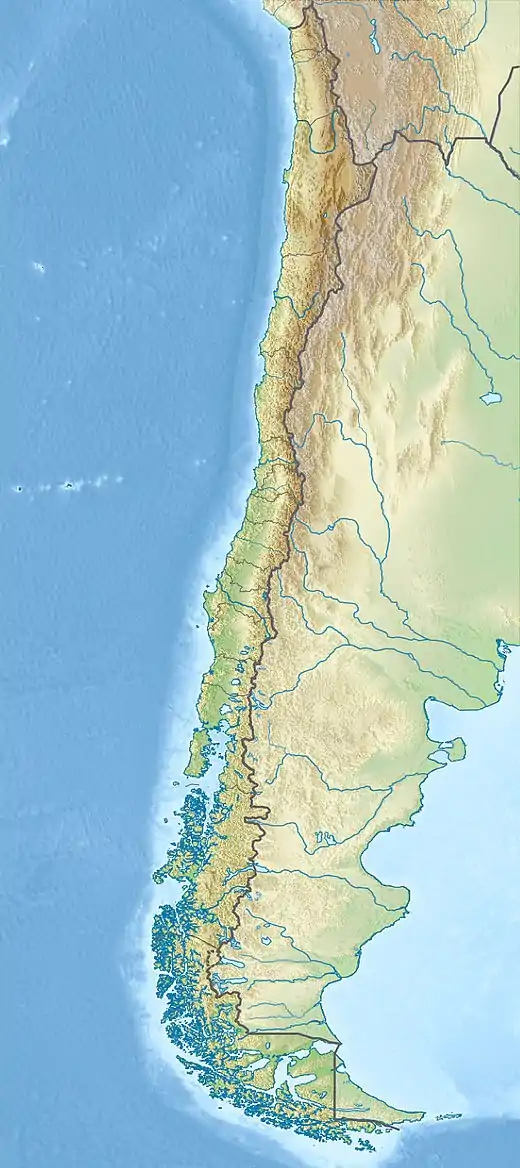Santo Domingo Formation
Santo Domingo Formation (Spanish: Formación Santo Domingo) is a mainly marine Miocene sedimentary formation located in south–central Chile.[1][3] The formation was defined by R. Martínez Pardo and Mario Pino in 1979 and named after the roadcut locality they studied about 19 kilometres (12 mi) southeast of Valdivia.[1][2] Sediments of the formation accumulated in Valdivia and Osorno–Llanquihue Basin.[3]
| Santo Domingo Formation Stratigraphic range: Miocene | |
|---|---|
| Type | Geological formation |
| Underlies | Pliocene and Quaternary sediments including Caleta Godoy Formation |
| Overlies | Bahía Mansa Metamorphic Complex, Cretaceous granitoids, Cheuquemó Formation, Estratos de Pupunahue |
| Thickness | Up to 110 m (360 ft) at surface[1] 1,500 m (4,900 ft) in subsurface[2] |
| Lithology | |
| Primary | Sandstone, siltstone, mudstone |
| Other | Conglomerate |
| Location | |
| Coordinates | 40.0°S 73.0°W |
| Region | Los Ríos & Los Lagos Regions |
| Country | |
| Extent | Osorno–Llanquihue & Valdivia Basins |
| Type section | |
| Named for | Cuesta Santo Domingo |
| Named by | Martínez Pardo & Pino |
| Year defined | 1979 |
 Santo Domingo Formation (Chile) Location of type section in Chile | |
The formations overlies basement consisting of metamorphic and igneous rocks; the Bahía Mansa Metamorphic Complex and Cretaceous granitoids respectively. In parts, it further overlies the coal–bearing Pupunahue–Catamutún Formation.[1] The sedimentary facies of the Santo Domingo Formation are composed of sandstone, siltstone and mudstone and smaller amounts of conglomerate.[2] The formation underlies Pliocene and Quaternary sediments.[2]
Fossil content
Some of the trace fossils that can be found in Santo Domingo formation are Zoophycos isp., Chondrites isp., Phycoshiphon isp., Ophiomorpha isp. Thalassinoides isp., Asterosoma isp. and Terebellina isp.[4]
The benthic foraminifera found in Santo Domingo Formation are broadly similar to those found in other Chilean sedimentary formations of the Neogene like Navidad Formation of Central Chile, Ranquil Formation of Arauco Province and Lacui Formation of Chiloé Island. [5] The most common formaineral species of Santo Domingo Formation are Hansenisca altiformis, Rectuvigerina transversa and Sphaeroidina bulloides.[6]
References
- Encinas et al., 2008
- Elgueta et al.., 2000, p.16
- Elgueta et al.., 2000, p.10
- Encinas et al., 2012
- Finger, 2013, p.374
- Finger, 2013, p.367
Bibliography
- Elgueta, Sara; McDonough, Michael; Le Roux, Jacobus; Urqueta, Esteban & Duhart, Paul (2000), Estratigrafía y sedimentología de las cuencas Terciarias de la Región de Los Lagos (39-41°30'S) (in Spanish), Santiago, Chile: Servicio Nacional de Geología y Minería, ISSN 0020-3939
- Encinas, Alfonso; Finger, Kenneth L.; Buatois, Luis A.; Peterson, Dawn E. (2012), "Major forearc subsidence and deep-marine Miocene sedimentation in the present Coastal Cordillera and Longitudinal Depression of south-central Chile (38°30'–41°45'S)", Geological Society of America Bulletin, 124 (7–8): 1262–1277, doi:10.1130/b30567.1, hdl:10533/135235
- Encinas, Alfonso; Buatois, Luis A.; Finger, Kenneth L. (2008), "Paleoecological and paleoenvironmental implications of a high-density Chondrites association in slope deposits of the Neogene Santo Domingo Formation, Valdivia, south-central Chile", Ameghiniana, 45 (1): 225–231
- Finger, Kenneth L. (2013), "Miocene foraminifera from the south-central coast of Chile", Micropaleontology, 59 (4–5): 341–492, retrieved 2019-02-21